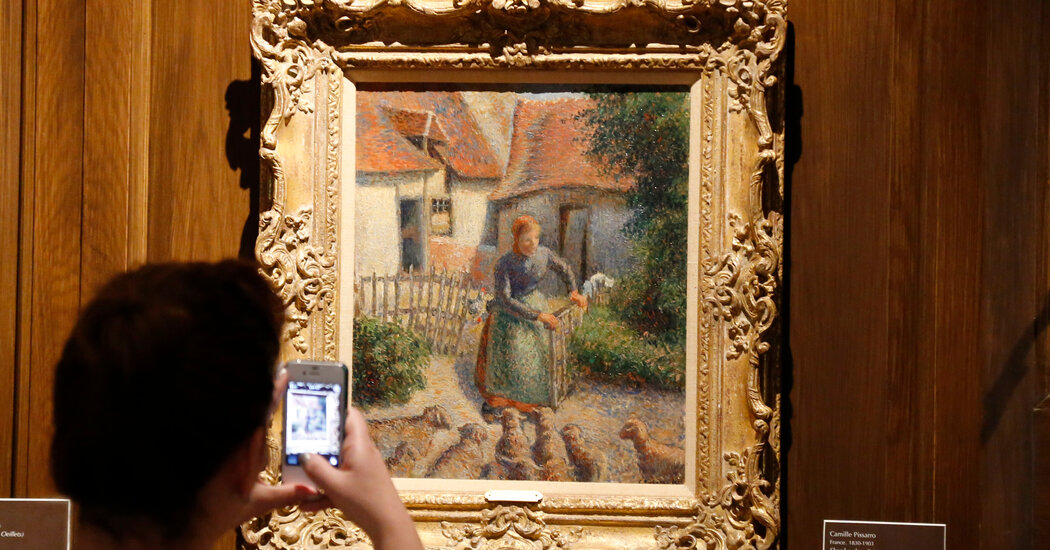French Heir Gives Pissarro Stolen by the Nazis to University of Oklahoma

A Jewish family whose relatives had their artworks looted by the Nazis said on Tuesday they were giving up their claim to a Pissarro painting and transferring ownership to the University of Oklahoma, where it had been on display until 2017.
Léone Meyer, whose family’s collection was looted by the Nazis, said she was giving up her long-running efforts to donate the painting to the Musée d’Orsay in Paris where it has been exhibited in recent years. Title to the work, “La Bergère,” or “Shepherdess Bringing in Sheep,” would instead go to the University of Oklahoma under an agreement that would ensure the painting continues to be exhibited in both countries.
“I have now regained my freedom at a price that I fully accept,” Dr. Meyer said in a statement about her plan for the painting, which she discovered in 2012 in the collection at the Oklahoma university, to which it had been donated in 2000. It was later transferred to the museum in Paris.
The announcement appeared to end the dispute over the painting, which had spawned court cases in both France and the United States and had already been the subject of an earlier negotiated settlement. In 2016, Dr. Meyer and the University of Oklahoma agreed that the painting would be returned to her but would be displayed at a museum in France for five years, then would rotate every three years between the university and one or more French institutions. As part of that plan, Dr. Meyer, 82, said that title to the painting, which Pissarro completed in 1886, would ultimately be transferred to an art institution in France.
But a legal tug of war started anew after Dr. Meyer, a survivor of the Holocaust, balked at returning the painting, as scheduled, to Oklahoma next month and sought to amend the agreement to permanently keep the painting in France.
A Paris court was scheduled to rule Wednesday on her efforts to keep the painting in France, after two earlier rulings in French courts had gone against her and the American Alliance of Museums and the Association of Art Museum Directors had come out in support of the university’s fight to maintain the settlement.
Dr. Meyer had hoped to donate the work to the Musée d’Orsay, but she said the museum refused because it did not want to assume the costs and risk involved.
Under the terms of the original agreement, the University of Oklahoma paid for the expenses of shipping and insuring the painting in transit, while Dr. Meyer took responsibility for the work in France. By agreeing to the revised settlement, she will no longer have to shoulder that responsibility.
The university will now take on the work of finding the French institutions to accept the painting for its three-year rotating public display, and of finding a long-term home for the painting in France.
In a statement, the University of Oklahoma said it would honor the future rotation agreement that would see the artwork move between the Fred Jones Jr. Museum of Art and France. Referring to the Oklahoma University foundation, it said it did not “intend for the OU foundation to retain title to the painting long-term” and said the painting might eventually find a home at another French public institution or the U.S. Art in Embassies program run by the Department of State.
Dr. Meyer and the University of Oklahoma and OU foundation “have restated and affirmed the original 2016 settlement agreement with a mutually agreed-upon modification in order to achieve its goals,” the university said in the statement. It said Dr. Meyer had “transferred title, interests and all standing connections with the Pissarro painting to the OU foundation. In turn, the OU parties have committed to identifying and transferring ownership to a French public institution or the U.S. Art in embassies program, subject to the parties original rotating three-year public display agreement.”
Until 1941, the painting had been in the possession of Dr. Meyer’s parents, Raoul Meyer, a businessman, and his wife, Yvonne. Dr. Meyer’s father was the longtime chairman of the Galeries Lafayette department store chain, which she later also served as chairman for several years.
Throughout the years of negotiations, the university never denied that the painting was stolen by the Nazis from the family during the occupation of France.
But it said in the previous court proceedings that it objected to returning the work because of procedural rules and the statute of limitations.
It also produced evidence that the previous owners, members of the Weitzenhoffer family, who bequeathed it to the university in 2000, had acted in good faith, having bought it at a New York gallery.
Under the agreement, Dr. Meyer, a former pediatrician, is putting forward $500,000 to help ensure that the cost of the rotation will be covered. For its part, the university has agreed to withdraw its claim for legal fees.
Dr. Meyer’s statement indicated that she understood that not everyone will be pleased with what she has decided. “Some will regret this perpetual rotation,” she said, “and others will celebrate it, but the students of the University of Oklahoma will remember that this work belonged to Yvonne and Raoul Meyer and that it was pillaged by the Nazis in France in 1941.”
Published at Tue, 01 Jun 2021 20:56:59 +0000
Article source: https://www.nytimes.com/2021/06/01/arts/design/pissarro-university-oklahoma-nazi.html